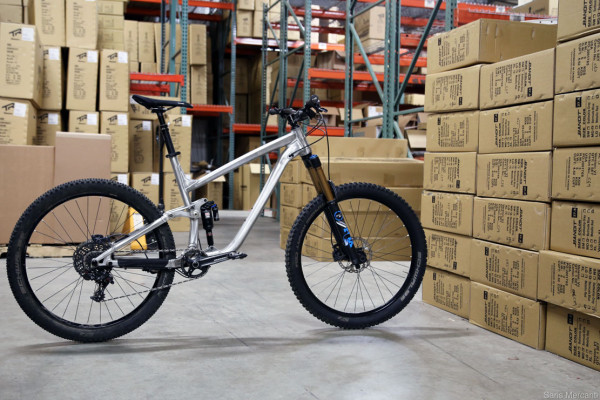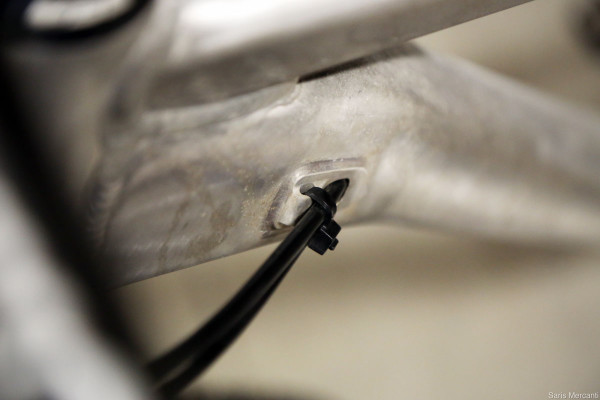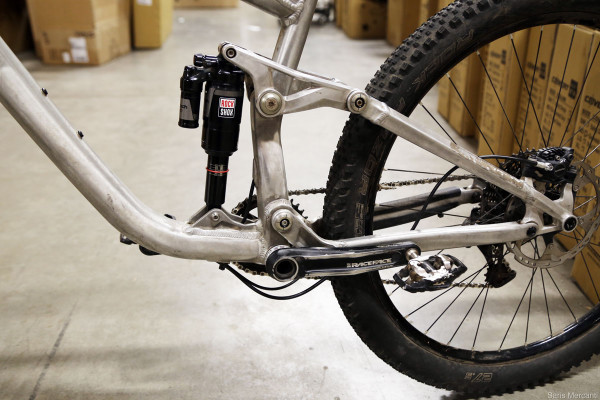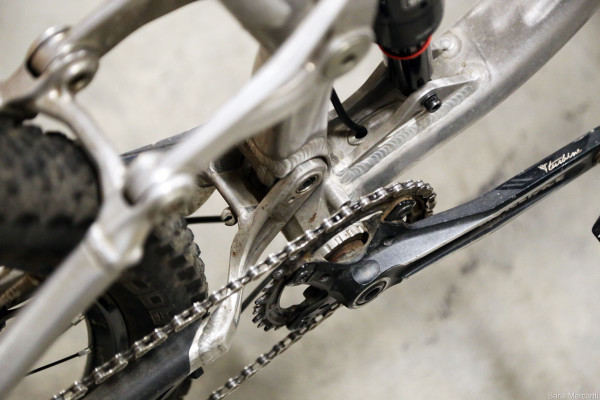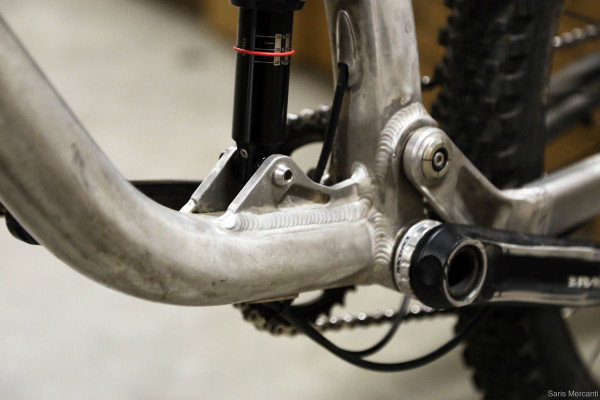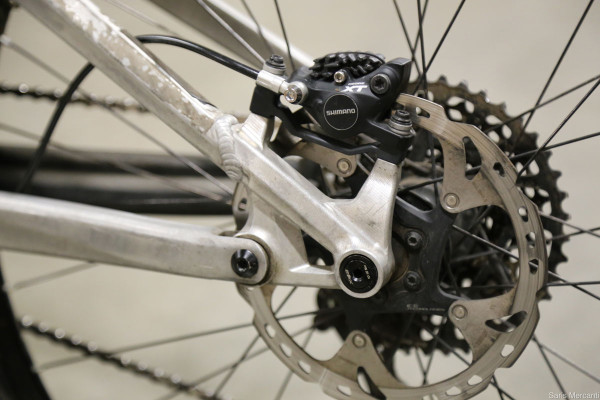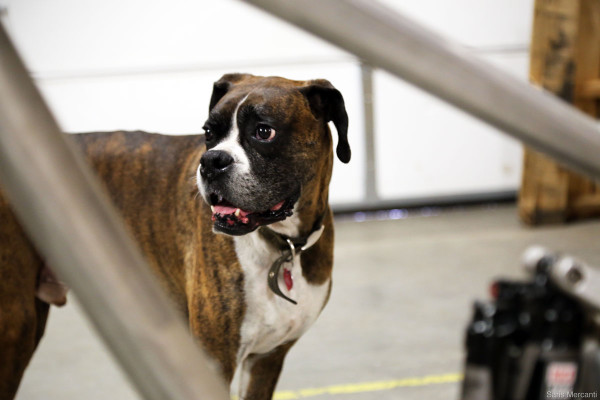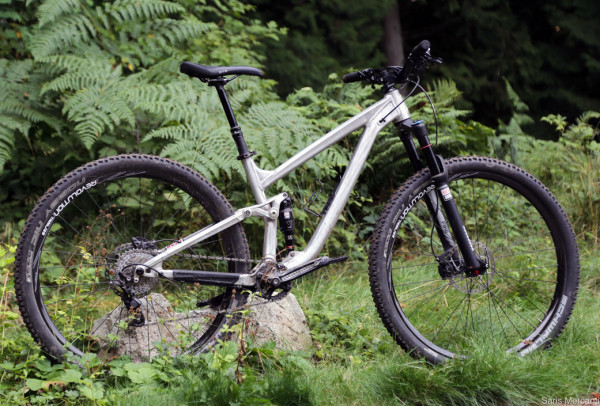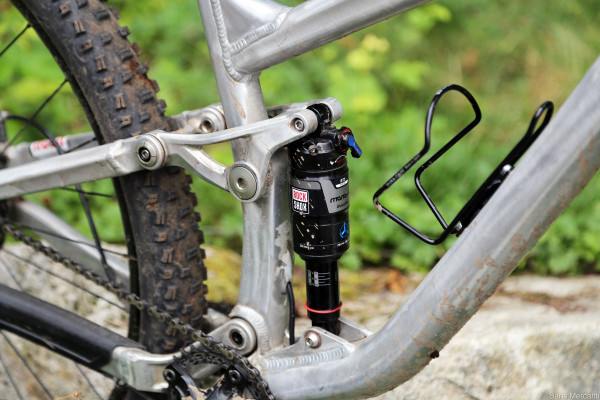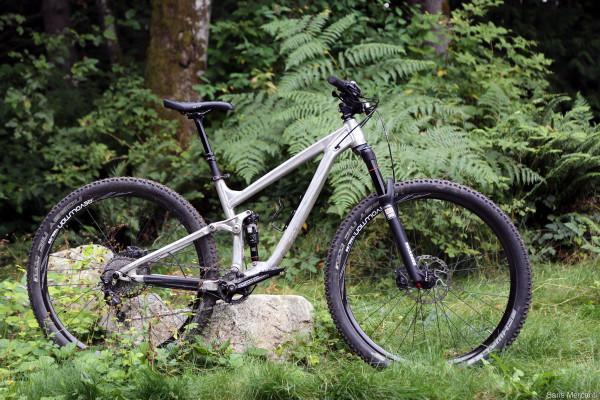On my return home trip from Whistler, I had the opportunity to stop by Transition HQ and take a quick peek at the new line of bikes they intended to debut at Eurobike. In development for two years, the new models mark a departure from the more free ride oriented fare the company has become associated with.
With the new range, they’ve debuted a new-to-them suspension platform they call Giddy Up, because of the improvement it offers in pedaling performance when compared to the older models. The platform is featured on their four newest models – a 29er, two 650b models, and a yet to be released 26″ variant.
When I arrived, the only production models had already been packed and shipped across the Atlantic, but I was able to get a closer look at the two test mules still at the office, and chat with the crew about the development process.
These cable routing ports are of Transition’s own design and keep the cable routing tidy and rattle free.
Out back, it #LookslikeaSession. At least sort of, which is because the small outfit from the Pacific North West is taking advantage of a patent heretofore owned by a company that shall not be named, which recently expired.
With design input from the engineering team who created the Switch Link system, Transition has retuned the suspension kinematics in order to improve pedaling characteristics, without sacrificing small bump sensitivity, or fun.
All four frames are front derailluer compatible (the mount is located near the main pivot about the BB), but in the future, their more “Enduro” models may drop that feature. They’ve found that much of the gravity oriented market has gone almost exclusively to 1x drivetrains, although 2x setups still remain popular on XC sleds.
To keep required upkeep to a minimum and stiffness high, they’ve gone with an expanding collet on the main pivot, and clevis pivots on the rocker link.
While the stays on this model, the 155mm Patrol, are middle of the road for added stability when racing, the company also has a shorter travel 125mm, the Scout, which could be considered the modern successor of the beloved Bottle Rocket.
Unfortunately, an adorable shop/trail dog is not included with the purchase of each new bike.
Even with photos of these prototypes, a dealer catalog leaked online, and the new line up about to be launched in a few days, it is incredibly rare for a company to let a media hack ride a bike unattended by a gaggle of product managers, marketing coordinators, and engineers. Yet, that is exactly what Transition let me do. After helping me setup up the suspension and controls, they gave me rough directions to the trail head, a map, and sent me on my way – completely unguided.
While I would have preferred to take out one of the 27.5″ models, the Patrol pictured above was only available in size gigantic, so I hopped on the sole full suspension 29er in their line up. It’s a short travel bike with only 115mm of rear travel, that they’ve paired with a 130mm fork up front, for a slack 67.5 degree head angle, and aggressive ride characteristics.
Front and rear, Transition has made the switch to RockShox suspension across the board. On most frames, the rule of thumb for setting sag is around 20-25%, depending on the suspension platform and preferred ride characteristics.
Darrin Seeds, the industrial designer/in house tester/and all around shredder, recommended setting the sag around 40%. This seemed excessive, particularly because of my previous experiences with owning several Transition frames.
In previous years, the simple single pivot suspension design employed by Transition had a falling rate, which had a tendency to blow through its travel on bigger hits. In order to alleviate the problem on my own bike, I installed a Fox Float Air Volume Spacer in my shock. The other issue with the single pivots was that they pedaled poorly, and even the more “XC” oriented models like the Bandit required assistance from a pedal platform to feel lively up hill.
During my ride in Bellingham on the Galbraith trail network, I ran into a local guy who was kind enough to show me around the maze of single track which criss crosses the mountain. Our ride was decidedly XC oriented at first, with lots of tight technical twisties, and fun undulating ribbons of trail.
Despite the hefty amount of sag, the Smuggler pedaled decidedly better than any Transition I’ve ever ridden. I was surprised that I never once felt the need to reach down and flick the go switch, but there was a learning curve associated with the big wheels, tight turns, and slack head tube angle. I’ve owned and ridden several Transitions in the past, and part of the reason I love the brand is how fun the bikes are, but it took me almost an hour of riding to master riding the Smuggler.
For the sake of full disclosure though, I do spend most of my time on bikes with smaller wheels, and my trails back home are more wide open. When the trail did open up, and we found some built up berms and doubles, the 29er felt at home pumping the backside of berms and squaring up berms.
While some riders will lament the new look, Transition’s new line up is a huge step forward for the little company. With the new suspension platform, they’ve made huge gains in pedaling performance and suspension sensitivity, without sacrificing the most important characteristic – fun. If you’re a long time fan of the brand, but you’ve been dabbling with other companies in search of something that pedaled better, you should definitely consider checking out the new line up.
Transition is here at Interbike with the new models, so stay tuned for a more detailed look at all the new bikes.
